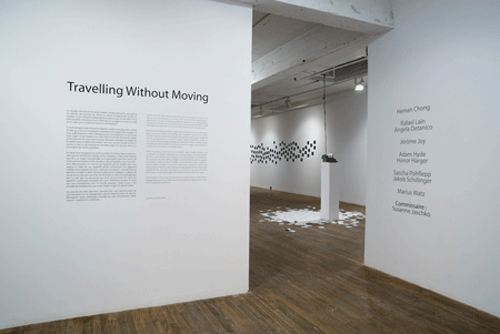 Travelling without Moving an exhibtion at Oboro, Montréal, Canada, November 3 - December 8, 2007 English version only The exhibition "Travelling without Moving" deals with today’s notions of travelling having changed due to an often mediatized perception of the surrounding world. Technological innovation has increased the speed of travel and the range of distances that could be reached in real time. By the same token, the modern traveller has developed a strong desire for the feeling of being connected to home. Mobile devices fulfil this desire, but also disconnect the traveller from his surroundings. One might argue that today’s mobility implies the movement on the surface -- on the surface of the city, on the surface of culture. That it means travelling without moving – and perhaps without being moved. The six selected artworks can be regarded as commentary on this changed perception and conveyance of the world. More than this, they are representatives of a new aesthetics of digital minimalism and "condensed experience." See more images of the exhibition on Flickr |
||||||||
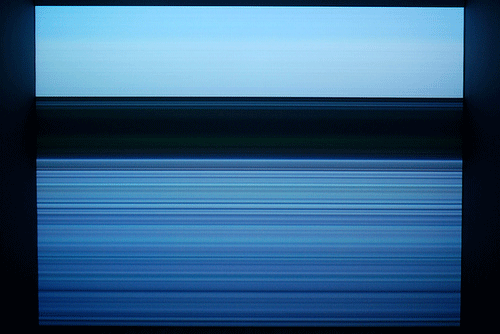 Angela Detanico and Rafael Lain (BR): Flatland In Flatland, Angela Detanico and Rafael Lain have digital video images of the Mekong River Delta landscape shot from a boat at evening. The mostly abstract images interact with the concreteness of the sounds recorded at the same time to carry the viewer into a word both real and detached, filled with a sense of flow of time and the river. • Angela Detanico and Rafael Lain have worked together since 1996, developing art and graphic design projects. They represented Brazil in the last Venice Biennale and will have a solo show at Optica parallel to Travelling Without Moving at OBORO. radioqualia (NZ): Radio Astronomy Listeners visiting the sound installation Radio Astronomy by radioqualia hear the live signal of radio waves received by a number of radio telescopes located throughout the world. This content of this live transmission of sounds from the cosmos depends on the objects being observed by the telescopes. On any given occasion, listeners may hear the planet Jupiter and its interactions with its moon, radiation from the sun, activity from far-off pulsars or other astronomical phenomena. • Radioqualia is a collaboration between by New Zealanders Adam Hyde and Honor Hager. It was founded 1998 in Australia. The development of Radio Astronomy was supported by The Fondation Daniel Langlois and is shown in Canada for the first time. Radioqualia website |
||||||||
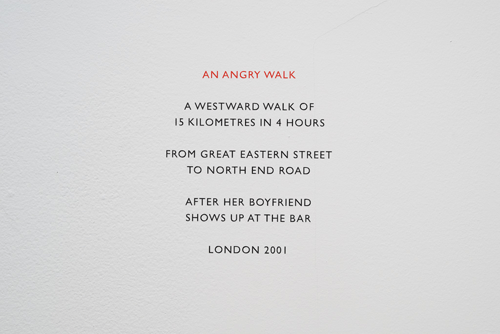 Heman Chong (SI): Walking Long And Hard The short poem-like vignettes comprised under the title of Walking Long and Hard by Singaporean artist Heman Chong reference Richard Long’s groundbreaking walking performances. Chong’s transference of the formal properties of these documentations to the present take place in the highly urbanised texture of cities around the world and are charged with psychological tension. • Amongst many other exhibitions, Heman Chong represented Singapore in the Venice Biennale in 2003. His artistic practice spans from installation and writing to video. He is represented by Vitamin Creative Space Artist's website |
||||||||
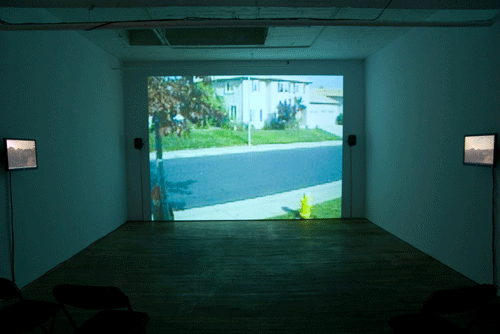 Jérome Joy (FR): nocinema.org nocinema.org brings the visitor to distant locations by using live footage of webcams across the world. On this basis the French Jérôme Joy created an automatic net-based documentary/fiction of interludes. For the sound part, each time offering a different overlay, Joy collaborates with a number or artists including Magali Babin, DinahBird, Christophe Charles, Yannick Dauby, Luc Kerléo, Alain Michon, Jocelyn Robert and Chantal Dumas. • Jérôme Joy is a composer and artist. Having delivered multiple performances of both instrumental and electro-acoustic music since the early 1980s, he has devised numerous international, networked projects with or without visual accompaniment: the reverse of the typical eyes-then-ears hierarchy. nocinema.org website |
||||||||
 Sascha Pohflepp and Jakob Schillinger (DE): Fixr The project Fixr by Germans Sascha Pohfelpp and Jakob Schillinger scrutinises the role of photography and the importance of the visual for memory. The Fixr website claims to be a free service that “helps you to close gaps in the digital record of your life.” It asks users to “submit a detailed description of the moment” they “missed”, i.e. did not take a picture of. The submitted requests are poetic in themselves, revealing desires and singular moments in an anonymous person’s life. • Sascha Pohflepp and Jakob Schillinger are at the beginning of their artistic career. Both graduated at the Berlin University of the Arts. Fixr website |
||||||||
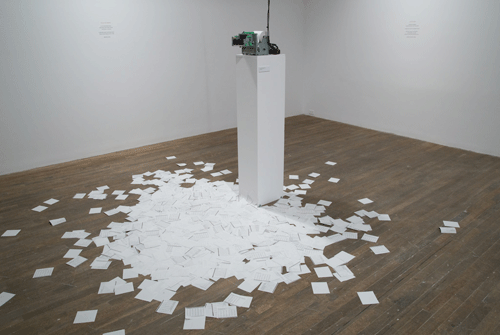 Marius Watz (NO): The Universal Digest Machine For Travelling Without Moving the Unversal Digest Machine embarks on a non-stop journey through the hyperuniverse of the World Wide Web on full autopilot. A web spider crawling the web digests the web pages it visits and puts out a printed analysis of their content. Over time the gallery floor will be swamped with the prints of this travel report. • Norwegian artist Marius Watz is concerned with generative systems for creating visual form. He lives in Berlin and Oslo where he teaches at the National Art Academy. Artist's website |
||||||||
|
Background In today’s highly medialized world, we are used to take images of reality for reality. Both, authentic reality and the simulated or documented reality either collapse to a vague idea of reality or lead to a conception of parallel verities. As soon as a new technology finds its way into everyday life, we start to change our behaviours. The more a new technology meets our needs, the more and quicker we adapt to it. Very often technology provides a supplementary offer to already existing options. On Finnair planes, the video image of an on-board camera, that is mounted to the lower front section of the air plane is shown to the passengers during take off and touch down. The small overhead monitors let them see the dreary asphalt of the runway, and its white stripes getting shorter and quicker in sequence while the air plane speeds up, until finally the plane’s nose cranes for the sky. The passengers witness the plane gaining distance from the ground, until the runway gets out of sight and the clouds cover the image with elusive shades of grey. The simultaneous recording and distribution of the moving image builds a different experience which together with the feeling of being physically lifted, the sound of the jets, the view out of the sight hole, and the smell of the leather seats etc. constitutes the reality at this moment. When it comes to the memorization of events, the image plays a dominant role in this process. As man has developed the cultural method of describing and documenting events with images over some thousand years, our brain is specialised in storing visual information prominently. To a large extend, we are used to base recalls and memories on (mental) images of the experienced, which explains the triumphant advance of photography in the last century and the even stronger impact that digital photography has on today’s culture. Modern technology enables the simulation of travel, and even one step further, the complete replacement of the traveller. Big ships that once have been built for the transport of oilrigs and huge cargo ships now cross the sea piggybacking yachts and small launches. This transport business has been noticeably expanding within the last two years, since the number of those ship owner increases who cannot afford to spend time on personally transporting their ships to sunnier regions of the world. Ironically, the boats -- being themselves means of travel and transport, and originally having been bought for leisure voyage and the experience of motion together with the elements -- go on a journey unaccompanied. Nam June Paik: "They travel to communicate, either to somebody. Or you just travel, driving, that means you are communicating with yourself through machines, like psychoanalysis. When you drive without reasons that is exactly like video feedback. Video feedback is communicating with yourself through machines. The psychic existence is the same whether you drive or if you do simple video feedbacks, it’s the same ontological structure." |
||||||||

